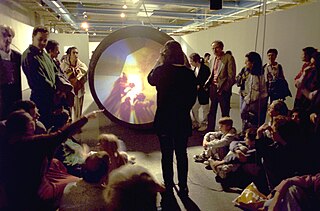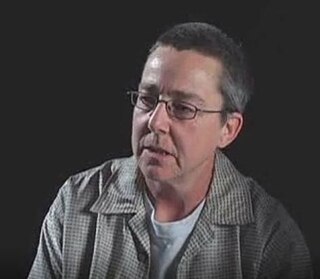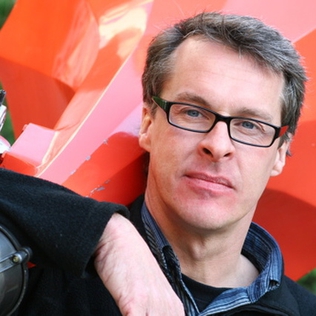Related Research Articles
Multimedia is a form of communication that uses a combination of different content forms, such as writing, audio, images, animations, or video, into a single interactive presentation, in contrast to traditional mass media, such as printed material or audio recordings, which feature little to no interaction between users. Popular examples of multimedia include video podcasts, audio slideshows, and animated videos. Multimedia also contains the principles and application of effective interactive communication, such as the building blocks of software, hardware, and other technologies. The five main building blocks of multimedia are text, image, audio, video, and animation. The first building block of multimedia is the image, which dates back 15,000 to 10,000 B.C. with concrete evidence found in the Lascaux caves in France. The second building block of multimedia is writing, which was first scribed in stone or on clay tablets and was mostly about three things. Property, conquest, and religion. Writing was soon abstracted from visual images into symbols that represented the sounds we make with our mouths. Thanks to the Egyptians, writing was evolved and transferred from stone to Papyrus. A cheaper but more fragile canvas derived from strips of the papyrus root grown on the Nile River.
Video art is an art form which relies on using video technology as a visual and audio medium. Video art emerged during the late 1960s as new consumer video technology such as video tape recorders became available outside corporate broadcasting. Video art can take many forms: recordings that are broadcast; installations viewed in galleries or museums; works streamed online, distributed as video tapes, or DVDs; and performances which may incorporate one or more television sets, video monitors, and projections, displaying live or recorded images and sounds.

Interactive art is a form of art that involves the spectator in a way that allows the art to achieve its purpose. Some interactive art installations achieve this by letting the observer walk through, over or around them; others ask the artist or the spectators to become part of the artwork in some way.

Interactive media normally refers to products and services on digital computer-based systems which respond to the user's actions by presenting content such as text, moving image, animation, video and audio. Since its early conception, various forms of interactive media have emerged with impacts on educational and commercial markets. With the rise of decision-driven media, concerns surround the impacts of cybersecurity and societal distraction.

A tangible user interface (TUI) is a user interface in which a person interacts with digital information through the physical environment. The initial name was Graspable User Interface, which is no longer used. The purpose of TUI development is to empower collaboration, learning, and design by giving physical forms to digital information, thus taking advantage of the human ability to grasp and manipulate physical objects and materials.
Strictly, digital theatre is a hybrid art form, gaining strength from theatre's ability to facilitate the imagination and create human connections and digital technology's ability to extend the reach of communication and visualization.
The terms dance technology and Dance and Technology refer to application of modern information technology in activities related to dance: in dance education, choreography, performance, and research.
Kate Armstrong is a Canadian artist, writer and curator with a history of projects focusing on experimental literary practices, networks and public space.

Established in 2009, the Faculty of Communication, Art and Technology (FCAT) at Simon Fraser University in British Columbia, Canada encompasses 5 Schools and Programs.
Deanna C. C. Peluso is an American-Canadian musician, composer, music educator, author and researcher currently residing in Honolulu, Hawaii and Vancouver, British Columbia. Peluso combines her academic and experiential background in music, psychology, performance art, technology and education to fuel what is called a unique style of research that focuses on how youth engage in Participatory cultures, social media and artistic and musical learning.

New media art includes artworks designed and produced by means of electronic media technologies, comprising virtual art, computer graphics, computer animation, digital art, interactive art, sound art, Internet art, video games, robotics, 3D printing, and cyborg art. The term defines itself by the thereby created artwork, which differentiates itself from that deriving from conventional visual arts. New Media art has origins in the worlds of science, art, and performance. Some common themes found in new media art include databases, political and social activism, Afrofuturism, feminism, and identity, a ubiquitous theme found throughout is the incorporation of new technology into the work. The emphasis on medium is a defining feature of much contemporary art and many art schools and major universities now offer majors in "New Genres" or "New Media" and a growing number of graduate programs have emerged internationally. New media art may involve degrees of interaction between artwork and observer or between the artist and the public, as is the case in performance art. Yet, as several theorists and curators have noted, such forms of interaction, social exchange, participation, and transformation do not distinguish new media art but rather serve as a common ground that has parallels in other strands of contemporary art practice. Such insights emphasize the forms of cultural practice that arise concurrently with emerging technological platforms, and question the focus on technological media per se. New Media art involves complex curation and preservation practices that make collecting, installing, and exhibiting the works harder than most other mediums. Many cultural centers and museums have been established to cater to the advanced needs of new media art.

Diane Gromala is a Canada Research Chair and a Professor in the Simon Fraser University School of Interactive Arts and Technology. Her research works at the confluence of computer science, media art and design, and has focused on the cultural, visceral, and embodied implications of digital technologies, particularly in the realm of chronic pain.
Julie Andreyev is a Vancouver-based multidisciplinary artist whose practice explores themes of animal agency and consciousness. Her ongoing Animal Lover work explores nonhuman animal agency and creativity through modes of interspecies collaboration and aleatoric methods. The Animal Lover projects seek to contribute towards an ethic of compassion and regard for the intrinsic worth of other-than-human individuals. She was born in Burnaby, British Columbia.

Luc Courchesne D.F.A. (1952) is a Canadian artist and academic known for his work in interactive art.

For the American jurist, see Nancy Paterson.
Tom Sherman is an American-Canadian artist working in video, audio, radio, performance, sculpture and text/image. He is also a writer of nonfiction and fiction. He is a recipient of Canada's Governor General's Awards in Visual and Media Arts. He is a professor of video art at Syracuse University.
Computer-generated choreography is the technique of using algorithms to create dance. It is commonly described as using computers for choreographing dances, creating computer animations, studying or teaching aspects of human movement, illustrating dance movements, or assistance in notating dances. It may also be applied in terms of choreographic software for stimulation, enabling real-time choreography and generative dance, or simulation with virtual dancers in the field of Dance technology. Historically, computers and dance can be traced back to the 1960s, for example, Michael Noll wrote an article about his work, titled "Choreography and Computers", published in Dance Magazine in 1967.
Lorna Boschman (1955) is a Canadian Queer media artist, film maker, curator, educator, editor, and camera operator working with themes such as sexual identity, body image, social justice, (dis)ability, cancer, abuse, health, and self-advocacy.
Zella Wolofsky is a Canadian modern dancer, researcher, columnist, and educator. During her dance career, she danced with various dance companies including Dancemakers, Winnipeg's Contemporary Dancers, Burnaby Dance, Laura Dean, and independent choreographers such as Jean Pierre Perrault, Muna Tseng, Elizabeth Chitty as part of 15 Dance Labs, founded by Miriam Adams and Lawrence Adams in Toronto, Canada.

Daniel Jolliffe was a Canadian media artist and art professor who created works of art, design and performance projects using new technologies including Global Positioning Systems (GPS).
References
- ↑ "Artist/Maker Name "Schiphorst, Thecla"". Canadian Heritage Information Network. Government of Canada. Retrieved 30 May 2016.
- ↑ Schibsted, Evantheia. "LIfeform". Wired. Retrieved 30 May 2016.
- 1 2 3 Joke Brouwer (2005). ARt & D: Research and Development in Art. V2_ publishing. pp. 263–. ISBN 978-90-5662-389-0.
- ↑ Salter, Chris (2010). Entangled: Technology and the Transformation of Performance. MIT Press. p. 264. ISBN 978-0-262-19588-1.
- ↑ David H. Jonassen; Association for Educational Communications and Technology (2004). Handbook of Research on Educational Communications and Technology. Taylor & Francis. pp. 466–. ISBN 978-0-8058-4145-9.
- 1 2 Johannes H. Birringer (1998). Media & Performance: Along the Border . JHU Press. pp. 118–. ISBN 978-0-8018-5852-9.
- ↑ Jackie Hatfield; Stephen Littman (9 August 2006). Experimental Film and Video: An Anthology. Indiana University Press. pp. 242–. ISBN 978-0-86196-906-7.
- ↑ Mark B. N. Hansen (2 October 2012). Bodies in Code: Interfaces with Digital Media. Routledge. pp. 65–. ISBN 978-1-135-87886-3.
- ↑ "Touch:Touche Daniel Jolliffe and Thecla Schiphorst. Curated by Nina Czegledy". Inter/Access. Retrieved 30 May 2016.
- ↑ "Thecla Schiphorst". Simon Fraser University. Retrieved 30 May 2016.